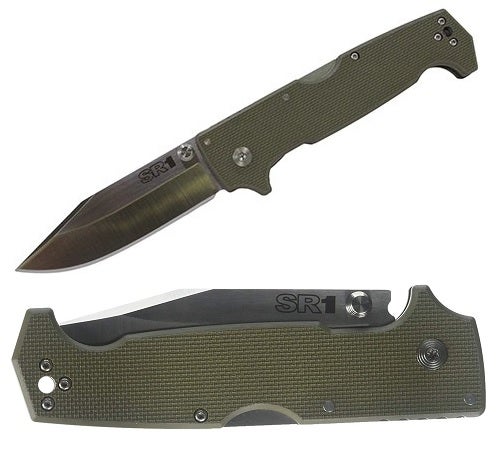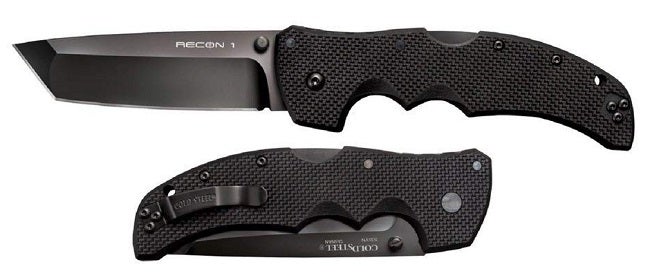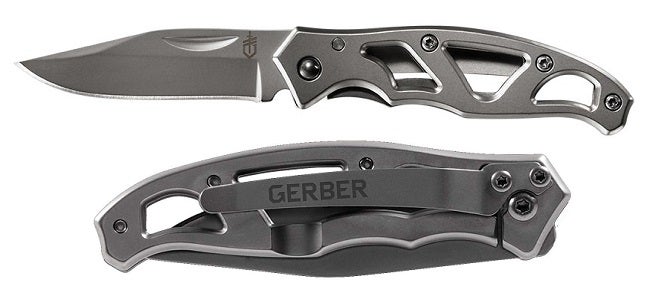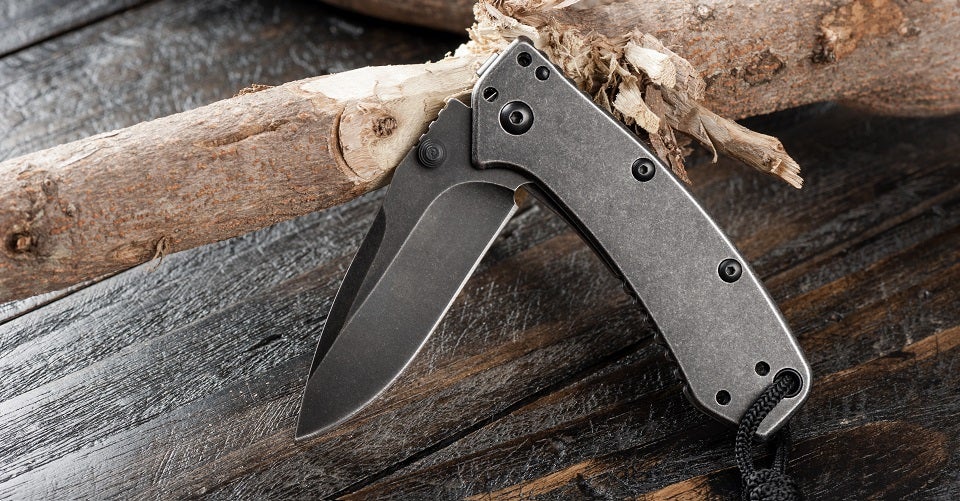
Our Editors independently research, test, and rate what we feel are the best products. We use affiliate links and may receive a small commission on purchases.
Whether you’re around the house or heading into the wilderness, a decent folding knife almost always has a place.
When we peel back the curtain and look at the broad world of folding knives, however, it quickly becomes overwhelming.
Folding knives come in all shapes, colors, quality, and materials.
Which type of steel is best for a folding knife? Is there a difference in the shape of the blade? How do we choose?
As an outdoor professional and backpacking guide, I’ve got the inside scoop to cut through the BS and find out what’s great and what can stay behind.
Let’s take a look at what some of the top folding knives are out there and how you can choose wisely.
Best Folding Knives
| Cold Steel SR1 Knife | CRKT Pilar Copper EDC Folding Pocket Knife | Kershaw Cryo Pocket Knife |
|
|---|---|---|---|
| Material: | CPM-S35VN Steel | 8Cr13MoV Steel | 8Cr13MoV Stainless Steel |
| Size: | 4 1/2" Blade | 4” Blade | 75” Blade |
| Weight: | 7.3 oz | 4.2 oz | 1.6 oz |
| Other: | Used in Military | 5 3/8" Handle | Speedsafe Opening |
For more of my camping recommendations, have a look through these popular Outside Pursuits guide links: Survival Knives, Hunting Knives, Fire Starters.
Quick Answer: The 8 Best Rated Folding Knives For 2021
- Cold Steel SR1 Knife
- CRKT Pilar EDC Folding Pocket Knife
- Kershaw Cryo Pocket Knife
- Cold Steel Recon 1 Tanto
- Gerber Quadrant Flipper Knife
- Gerber Paraframe Mini Knife
- Victorinox Swiss Army Classic SD
Our reviews of the top rated folding knives with our comparison table and buyers guide will help you choose the right one for you.
Folding Knife Reviews
#1 Cold Steel SR1 Knife
- Material: CPM-S35VN Steel
- Size: 4 1/2″ Blade
- Weight: 7.3 oz
- Other: Used in Military
Cold Steel is inarguably a well-loved brand. Loyalists enjoy the often tactical aesthetic and the company focuses on producing blades with the most-hyped materials and methods.
Ready for a head spinner? This knife is made with S35VN steel which is, at its core, stainless steel.
It’s improved with some small changes to chemical composition which supposedly offer increased resistance to chipping and improved edge retention though I struggled to find independent research on the matter.
That said, there’s likely some real-world improvement to blade quality though you’ll pay for it. Literally. This knife is the most expensive folding knife on our list by a long shot so don’t lose it!
It’s a gorgeous aggressive drop point blade with a full-size 5 – ⅜” handle featuring textured G10 for a great grip. I personally love the rugged look and feel and I’m sure it will appeal to anyone who likes the military or tactical aesthetic.
At the end of the day, this is a big knife. It’s not going to disappear in your pocket.Best for improved stainless blade steel on a full-size rugged frame with positive grip texture.
#2 CRKT Pilar Copper EDC Folding Pocket Knife
- Material: 8Cr13MoV Steel
- Size: 4” Blade
- Weight: 4.2 oz
- Other: Limited Lifetime Warranty
CRKT places a knife on our list by sticking with the basics. Affordable price, generalist form, and an effective lineup of features.
This one blends form and function, however. I love the sleek elegant curves they put on this otherwise simple knife.
The relatively short blade has a rounded belly that makes for easy and effective cutting work from a variety of comfortable angles.
The blade itself lacks a defined tip though the upswept belly does give it just a bit of dexterity around the nose.
They’ve made the whole thing revolve around a smooth handle and frame design specifically meant to avoid snagging on pockets.
Some of you will be very happy to note that the pocket clip is reversible.
Unfortunately, the machining marks where the reversible screws are located somewhat detract from the sleek form of this knife.
High marks for ergonomics and practicality yet a design that stands out from the crowd.
#3 Cold Steel Recon 1 Tanto
- Material: S35VN Steel
- Size: 4” Blade
- Weight: 5.2 oz
- Other: 5 3/8″ Handle
Cold Steel gets a second spot on our list today because they’re one of the only manufacturers producing an all-time favorite style of mine – the Tanto.
Not just any tanto shape, though, this is a no-nonsense practical folder. Together the SR1 and Recon 1 share a lot of similarities from Cold Steel.
They’re both based on the same improved stainless steel. Both rely on texture G10 handle slabs for grip and looks. Both use the Tri-Ad lock mechanism.
What’s really different about them is the blade shape. Tanto blade knives, while increasingly popular, are still a bit of a statement.
Their shape lends a strong blade tip that excels at puncturing and prying (though I don’t recommend it). It also just has that sexy tactical feel.
While it may not be a 5/5 for all-around practicality I do love the fine-edge tanto style and Cold Steel did a great job executing that here.
Best for style points without sacrificing functionality.
#4 Kershaw Cryo Pocket Knife
- Material: 8Cr13MoV Stainless Steel
- Size: 75” Blade
- Weight: 1.6 oz
- Other: Speedsafe Opening
Kershaw has been around for ages making pocket knives that run the spectrum from ultra-tactical to reasonably practical.
This one is packed with features that make it pragmatic and appealing. Made from a stainless steel alloy, this blade is able to deal with nasty elements without rusting up.
The frame is also made from steel and features the same coating as the blade which makes for a great seamless look. Overall it’s a simple blade with a proven drop point shape on modest length.
Deployment is done via a thumb stud or finger tab both of which are partially assisted using a Kershaw designed mechanism.
This one makes our list as a top pick for all-purpose, great value in a practical package.
#5 Gerber Quadrant
- Material: 7Cr17MoV Stainless Steel
- Size: 7” Blade
- Weight: 4.6 oz
- Other: Limited Lifetime Warranty
Flipping the spectrum on its head is the Gerber Quadrant.
I’ve always loved Gerber’s reasonable pricing but rarely do they deliver such a stand-out design and I have to say, I love this one.
The longest blade we’ve reviewed so far is also, perhaps, the most ambitious.
This totally flat (from handle to blade) knife profile reminds me of an old-time wood working tool like a froe or a shingle splitter for cedar shakes.
Without any defined point, this blade makes a good choice for work where you don’t want to accidentally stab something (or someone) such as rescue or salvage operations.
All the standard features are here as well. Pocket clip, blade lockout inherent in the frame, and an easy-to-use finger flipper.
Somehow they even managed to keep the price down to an entry-level fee. Best for making a modern statement while keeping things affordable and practical.
#6 Gerber Paraframe Mini Knife
- Material: Stainless Steel
- Weight: 1.6 oz
- Size: 2” Blade
- Other: Limited Warranty
Gerber makes the list again, this time delivering a small pocket knife with balanced features. When it comes to everyday carry, nothing beats lightweight and practical.
I’ve owned probably half a dozen of these in my life. It’s not because they break, it’s just because I keep losing them.
I just replaced them with a new one, though, because I’ve yet to find something more affordable or practical.
Using the old-school clip point design, this knife has good cutting and puncturing ability. That said, the small skeleton frame design isn’t made for heavy work.
This knife is great for daily chores like slicing cable ties, cutting ropes, or dividing up the summer sausage.
There’s a strong argument to be made that anyone would be hard-pressed to find a more functional folding knife in the price range.
Best for simple daily tasks from home to work and back again.
#7 Victorinox Swiss Army Classic SD Pocket Knife
- Material: Stainless Steel
- Size: 25” Blade
- Weight: .74 oz
- Other: 7 Functions
This knife has got to be one of the best-selling and most recognizable brands in knife history. It’s hard to imagine a folding knife with more versatility than the Swiss Army Knife.
I got a Swiss Army Knife as a kid and loved it. Until I got older and “tactical” knives became the cool thing.
I then considered the Swiss Army Knife a gimmick of a tool until I got into ultralight backpacking as an adult.
That’s when I realized that it may be impossible to find a knife with more utility and value in such a small, lightweight package.
Don’t get me wrong – this is no tactical Rambo knife.
But if you’re an average Joe like the rest of us then you might enjoy the tweezers (I use them weekly), keyring attachment, or scissors (surprisingly strong).
I’ve used the scissors to cut cable ties and trim fingernails for years! Don’t bring this one to a knife fight, though – it’s better suited to everyday tasks.
Folding Knife Comparison Table
| Folding Knives | Material | Size | Weight | Other | Rating | |
|---|---|---|---|---|---|---|
| Cold Steel SR1 Knife | CPM-S35VN Steel | 4 1/2" Blade | 7.3 oz | Used in Military | 4.3 / 5.0 | |
| Cold Steel Recon 1 Tanto | S35VN Steel | 4” Blade | 5.2 oz | 5 3/8" Handle | 4.7 / 5.0 | |
| Kershaw Cryo Pocket Knife | 8Cr13MoV Stainless Steel | 75” Blade | 1.6 oz | Speedsafe Opening | 4.5 / 5.0 | |
| CRKT Pilar | 8Cr13MoV Steel | 4” Blade | 4.2 oz | Limited Lifetime Warranty | 4.6 / 5.0 | |
| Gerber Quadrant | 7Cr17MoV Stainless Steel | 7” Blade | 4.6 oz | Limited Lifetime Warranty | 4.4 / 5.0 | |
| Gerber Paraframe | Stainless Steel | 1.6 oz | 2” Blade | Limited Warranty | 4.5 / 5.0 | |
| Victorinox Swiss Army Classic | Stainless Steel | 25” Blade | .74 oz | 7 Functions | 4.7 / 5.0 |
How to Choose the Best Folding Knife for You – Buyers Guide
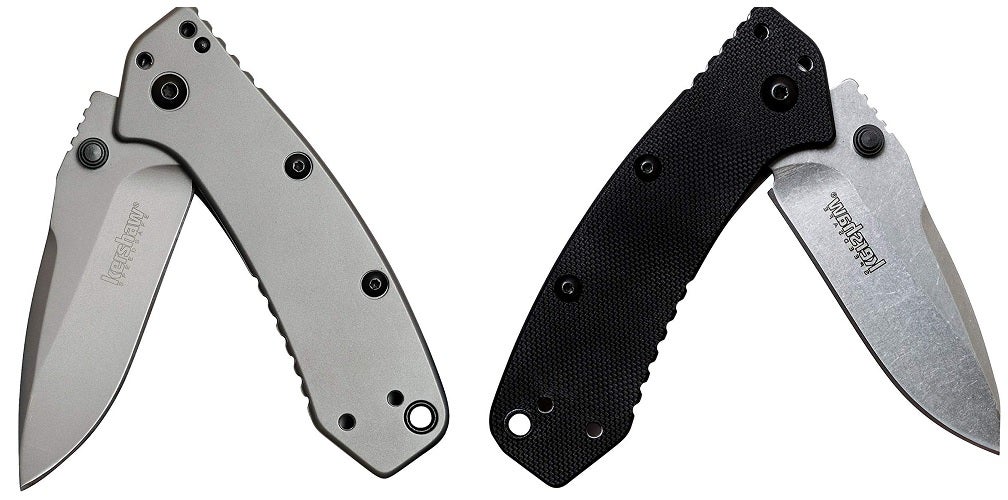 There’s a lot to know about knife science, theory, and metallurgy. Even worse, there’s a lot of controversy and opinion out there around the subject.
There’s a lot to know about knife science, theory, and metallurgy. Even worse, there’s a lot of controversy and opinion out there around the subject.
I’ll shed some light on the subject with years of experience as a blacksmith.
Types of Steel
One of the first and biggest hurdles you’ll encounter is understanding types of steel. There’s a lot to know and a lot of misnomers to step around.
- Stainless Steel – high chromium corrosion resistant steels
- Mild Steel – low to moderate carbon content steels
- High Carbon Steel – steels with carbon contents suitable for heat treatment
Which type of steel is “best” really depends on your intended use for the knife. Do you plan to have it in corrosive environments like cutting high acid fruits?
Getting it wet and not cleaning it often? Go with stainless steel. Need a knife with the best possible edge retention and metallurgical properties tuned just right?
Go with high carbon and be ready to keep it clean and oiled. Steel types tend to get overhyped and blown out of proportion.
In all reality, even basic stainless steel will hold an edge just fine and can easily be re-sharpened almost endlessly.
Steel grades will often be cited by manufacturers and other enthusiasts. For a brief intro to steel grades give the Wiki a read.
Steel and materials manufacturers have some good information available as well, like this brief look at steel grade nomenclature.
At the end of the day, steel grades and chemical composition get bandied about like a marketing tool.
In reality, there are thousands of steel alloys out there and each one is specifically good at a narrow range of things and intended to be worked and heat-treated in specific ways.
Every knifemaker and knife enthusiast has their own opinions about what steels are the “right” ones.
Instead of giving you my own opinions, I’m going to encourage you to do your homework with some unbiased sources about steel types, how they’re made, what they’re good for, and how they should be used and heat treated.
For a more in-depth understanding of steel types, heat treating, and how that applies to the knife world I recommend this basic article from AnvilFire – a blacksmithing resource.
Pro Tip: If you want to cut to the chase, just get an affordable stainless steel folding knife.
They work just fine, won’t rust, are readily available, and cheap enough that if you lose it you won’t cry yourself to sleep at night.
Knife Shapes
When it comes to folding knives, blade shapes can be wildly artistic.
For practical purposes, there are probably only one or two blade shapes that really make the most sense for utilitarian value in a folding knife.
A great folding knife is sometimes more a work of art, though, so don’t discount wild shapes!
Tanto
Tanto blade refers to a Japanese weapon that gave this knife its shape.
Tantos are extremely durable because their tip is short and diamond-shaped in cross-section which makes them quite durable.
For stabbing and prying, you can’t get much better but I don’t recommend doing that with a knife in the first place.
Sheepsfoot
Sheepsfoot blades are flat along the blade while the spine falls sharply to the tip near the end of the blade.
These are great for splitting if you want a survival knife for that work because they resemble a froe.
Trailing Point
Trailing point blades are extremely long, slender slicing blades.
You might recognize them as a fillet knife and you’ll be unlikely to see them in a folding knife unless it’s specifically for fishing.
They’re poorly suited to anything other than filleting fish.
Spey Point
Spey point blades feature a tip that is flat and un-sharpened with a very minimal blade profile. Along its length, these blades tend to be flat on the belly and spine.
These blades are great for skinning and gutting work!
Drop Point
Drop point knife shapes are maybe the most common shape out there. On the back, the knife’s spine falls slightly, usually near the tip, and the blade sweeps gently up to meet it.
These are great general-purpose knives that get it all done.
Clip Point
Clip point blades fall sharply into a thin point near the tip. They’re great for fine work and strike a balance between a trailing point blade and a drop point blade.
Blade Bevels and Grinds
Like a lot of things in the hobbyist knife world over the last few years, blade bevels and grinds have attracted a lot of attention and opinion.
What’s most important to keep in mind is that each shape has pros and cons – the right one for you will depend on how you want to use your knife.
Bevel
Refers to the area of the knife where the full thickness of the spine transitions into the thinnest part of the blade.
Bevel Angle
Refers to the steepness of the fade from full-thickness to blade edge.
Grind
Usually refers to the shape of the sharpened blade, specifically the primary and secondary bevel, when viewed in cross-section.
Grind Types
Grind type simply refers to the cross-sectional shape used to sharpen the final bevel, or edge, as it falls into the edge of the knife.
Each type of blade grind has pros and cons. We’ll cover a few of them here:
Hollow Grind
Hollow grind is a concave grind that leaves an extremely thin, extremely sharp, and very fragile edge on a blade.
These can be most commonly seen on straight razors where the blade is subject to delicate work that requires extreme sharpness.
Hollow ground blades tend to be so sharp that they can often be brittle.
There is so little martial left at the edge of the blade that chipping can be a common issue if the steel being used is overly hard or too thin.
Flat Grind
Flat grind is a straight, even taper from full-thickness to the final blade edge. Viewed in cross-section it looks like a triangle.
A short, steep flat grind creates a blade with great strength and durability while a shallow flat grind tapering all the way to the spine may create a sharp, yet fragile thin blade.
The bevel angle is the defining feature that differentiates different flat ground blades.
Convex Grind
Convex grind is the opposite of a hollow grind. The blade profile, when viewed in cross-section, falls over in a slow arc somewhat like the shape of a bullet.
These blades are extremely durable because they leave a maximum amount of material to support the blade. Convex grinds are most appropriate for extremely abusive situations.
This grind type is common on things like splitting mauls which need extreme durability because they’re often smashed into the dirt.
Blade Length
Overall the length of a folding knife blade needs to be 3 things:
- Practical
- Appropriate for the purpose
- Legal
In some areas a folding knife, especially when carried in a pocket, becomes subject to certain laws.
We won’t go over these, but I will say that you must be sure that your blade is legal to carry, particularly if you’re taking it anywhere public.
Practicality is an easy one – if you fold your knife up will it still fit in your pocket or on your belt? Sure, you can fold a sword in half but that won’t make it a good pocket knife.
Remember that if you plan to carry a folding knife every day, smaller is a lot more comfortable. Determining a blade’s appropriateness depends on what you want to use it for.
For splitting little pieces of wood in a woodsman or survival situation, you probably want something decently long and beefy.
For opening mail and slicing boxes, you may want something a lot smaller and lighter. Just check in with yourself before deciding to see if the knife you’re considering buying is the right size for your job.
Handle Materials
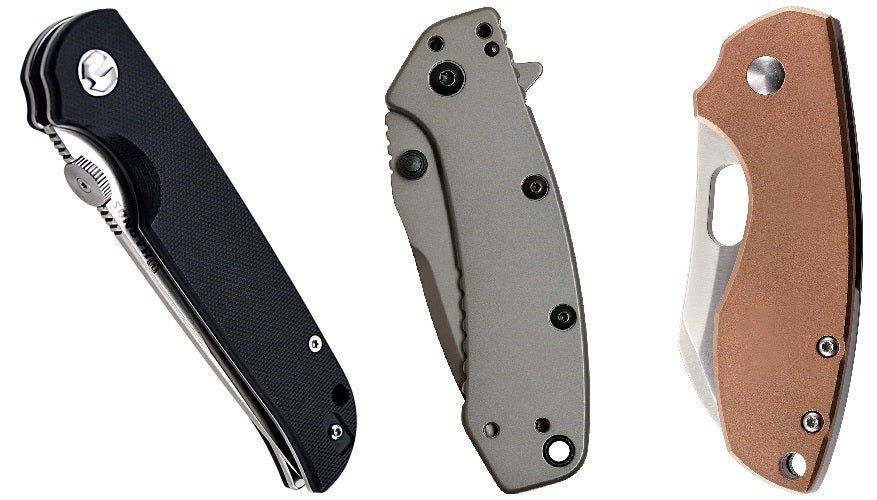
When choosing your folding knife there are a lot of different types of handle to understand. Materials range from the mundane to the exotic and synthetic.
Choosing the right handle type is a combination of personal style and function.
Wood
Has been the handle material of choice since time immemorial. Wood comes in just about any color and texture you can think of.
One material that really pops is stabilized wood and wood burl.
Burls are swirly with great colors and synthetic resin can be used to add crazy style to these otherwise normal wooden handle materials.
Metal
Handles are probably the most durable and often the cheapest. Aluminum is the metal of choice for most folding knife frames and handles, both.
It’s great because aluminum is both lightweight and rust-proof. Metal handles are no-nonsense options.
Micarta
Is a laminate of layers of cloth which, when shaped, creates a very appealing textured visual. Micarta, if done right, can be very good at absorbing sweat and aiding grip.
Kyrinite
Is a resin handle material which can come in pretty much any color under the sun. These handles feature beautiful swirling colors and can really stand out in a crowd.
Kyrinite is somewhat famous for being prone to cracking under heavy use, though, so don’t try pounding nails in with it!
G10
Is another synthetic fiber/resin combo.
G10 is tough as nails though handles made from pure G10 tend to be a bit pricey despite the fact that the material itself isn’t particularly scarce.
Locking Mechanisms
Every folding knife has some way of staying open once deployed. Far and away the most common is a simple spring lever usually inherent to the body of the knife.
Other methods run the gamut of complexity. Type of locking devices are really only limited by the designer’s imagination.
Instead of detailing them all, let’s just talk about what to look for. Be certain your folding knife has a reliable lock.
Open the knife and check that the locking device is securely and positively in position. Check that you can easily operate the lock to disengage it.
With your fingers out of the way, test to be sure the blade will stay open even under pressure and that the lock retains its integrity before use.
Some folding knives, particularly those with opening assists, will have a lock to ensure the knife stays closed as well.
With the knife closed and locked, attempt to safely deploy the blade.
Be sure that the lock maintains positive control on the blade when in the closed position as having your knife pop open in your pocket could be catastrophic.
Opening Mechanisms
A folding knife has to be able to fold and open easily (and safely) to be of any use at all. That’s why we’re going to take a look at how this is done and what you need to pay attention to.
Please note that some blade opening types such as assisted, switchblade, partial assist, etc. may have legal implications.
Be aware of the laws in your area governing knife type and use before buying.By far the most common and reasonable type of opening mechanism is… none at all!
A simple folding knife where all the work is done by your thumb or fingers remains the most practical and simple choice.
Assisted opening knives are fun! They range from spring loaded to flick levers operated by a thumb or index finger with the flick of the wrist.
An assisted opening knife’s purpose is to be more rapidly deployable. Some see this as a for-fun feature while others see it as a self-defense or assault feature.
Personally, I don’t see a need for assisted opening knives for utility purposes so I recommend others steer clear of them, particularly given the potential legal implications they bring with them.
Plus I find that the assist mechanisms, locks, and safety features become an unnecessary complication of what is otherwise a simple and reliable tool.
I do enjoy, and recommend a finger tab style opening mechanism.
It’s a very handy simple design feature that streamlines the opening process for your folding knife though it is, admittedly, unnecessary.
Intended Purpose
One of the most important factors in choosing a knife that few people talk about is “intended purpose”. I use this phrase to mean, “how do you want to use your knife?”
If you want to use your knife for digging, prying, chopping, hacking, opening cans, and other hard abusive tasks that will affect your knife choice.
You’ll want something with a sharp edge angle for a durable blade and you’ll probably want something like a tanto point for durability.
If, however, you need something for fine slicing and cutting like skinning then the choice would be different. A hollow ground drop point or even trailing point knife would make sense here.
Before buying, think about what you want to use the knife for.
FAQs About Folding Knives
Q: What steel holds the sharpest edge?
A: Remember, sharpness is a combination of factors. Hollow ground edges tend to have the sharpest overall function.
That said, they tend to be a bit brittle. Additionally, edges without burrs have substantially improved sharpness.
Learn to check for burrs with your thumbnail and remove them with good sharpening techniques.
Edge sharpness, in terms of steel types, is a bit of a misnomer though you’ll find that quality carbon steels likely take and hold the best edges over time.
Things like O1, D2 or 1095 are totally fine for taking and holding an exceptional edge.
Remember that a lot of factors affect edge sharpness and most of them have nothing to do with steel composition at all.
Q: Are carbon steel knives better than stainless?
A: In terms of raw performance when subjecting a knife to “performance tests”, yes, carbon steel knives are capable of excelling further than most stainless knives.
In everyday use, however, a stainless steel knife is likely to perform any task just as well as a carbon steel knife.
Remember that knives are meant for fine cutting work – they’re not hammers, axes, or chisels.
Carbon steel knives have the potential to be heat treated in specific ways that can make them extremely hard, extremely durable, and/or extremely flexible.
A knife made of the correct carbon steel and heat treated the correct way for the intended use of the knife will outperform a stainless knife by most metrics.
Q: What is heat treatment?
A: Heat treatment is the process by which steel is hardened and tempered.
Hardening causes the crystal structure of the steel to close up in specific ways that result in an increase in hardness and brittleness.
Tempering actually undoes some of the hardening process. Most steels, after hardening, are so hard that they’re uselessly brittle.
By tempering the steel to certain specifications the end result can be super hard, flexible and soft, or somewhere in between.
The type of heat treatment needed for any specific steel is not magic or mystery – these processes are understood and laid out in scientific documentation from the alloy manufacturers themselves.
Q: How do you sharpen a knife?
A: There are a lot of ways to sharpen a knife and everyone has their favorites. By far the easiest and most reliable method is to use a jig system such as the popular Lansky.
These jigs hold the knife blade steady while you use a predetermined stone on a slide to keep the edge even and repeatable.
These jig systems overcome the problem of sharpening at the wrong angle. Also, they make it easy to repeat your sharpening process every time and they’re a great idea for beginners or experts.
Conclusion
Without a doubt the best thing you can do before you buy a knife is think about how you want to use it. This will help you determine which characteristics you need.
From there you can make a good decision based on your own needs and not other people’s opinions.
Don’t forget to revisit the “how to choose” section before you set off and buy your next great folding knife!
How We Researched
To come up with the top folding knives we researched a variety of sources for reviews such as REI, Bass Pro Shops, Cabelas and Backcountry along with our own personal experience.
We also consulted online magazines for product research and reviews to get as much unbiased information as we could. To help weed out fake reviews we used Fakespot.com to make sure we only looked at genuine reviews.
With so much quality gear available, we had to narrow it down based on what we felt were the best options for the price. The author, Casey Fiedler has been leading backpacking trips for over a decade in his native state of Michigan.
To help narrow down the selection he used his personal experience along with recommendations from fellow guides and outfitters.
After extensive research, we came up with our list to help you choose the right one for you.
Sources

